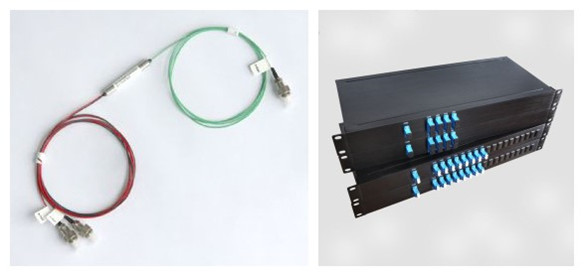OADM (Optical Add-Drop Multiplexer) is one of the intelligent techniques for the handling of communications signals. According to a new study from ElectroniCast, OADMs and their components are destined for continued market prosperity. In fact, The global consumption of OADM has been rising rapidly from 1998 until now. Then what makes OADM so popular? This paper will make a review of OADM to help you better understand it.

What Is OADM?
OADM is a critical device used in wavelength-division multiplexing systems for multiplexing and routing different channels of light into or out of a single mode fiber. It is the fundamental constructional block of optical telecommunications networks. OADM has passive and active mode depending on the wavelength. In passive OADM, the add and drop wavelengths are fixed beforehand. But in dynamic mode, OADM can be settable to any wavelength after installation. OADMs can be deployed for both expensive remote core networks and shorter distance networks, which are also called metro networks.
Structure of OADM
There are three stages in a traditional OADM: an optical demultiplexer, an optical multiplexer, and between them a method of reconfiguring the paths between the optical multiplexer and a set of ports for adding and dropping signals. The multiplexer is used to couple two or more wavelengths into the same fiber. Then the reconfiguration can be achieved by a fiber patch panel or by optical switches which direct the wavelengths to the optical multiplexer or to drop ports. The demultiplexer undoes what the multiplexer has done. It separates a multiplicity of wavelengths in a fiber and directs them to many fibers. The following diagram shows the working principle of OADM.

FOADM VS ROADM
Generally, OADMs can be divided into two types: FOADM (Fixed Optical Add-Drop Multiplexer) and ROADM (Reconfigurable Optical Add-Drop Multiplexer).
The FOADM is a traditional wavelength arrangement scheme that can only input or output a single wavelength via the fixed port. FOADM is used to add or drop a certain set of wavelengths dedicated to specific DWDM channels. It allows the manufacturer to customize the number of channels, filter specifications, and power equalization but require excessive transporters at each node. Besides, in FOADM systems, manual adjustments are required because channels are added or dropped. And optical-to-electrical and electrical-to-optical alterations are also necessary. Normally FOADM is built with thin-film filters (TFFs) fiber Bragg grating (FBG) and integrated planar arrayed waveguide gratings (AWG). The operational cost is high for FOADM because of the stationary nature of the arrangements and the requirement of manual changes.
The ROADM is a dynamic wavelength arrangement scheme, which allows for dynamic wavelength arrangement scheme. It uses a Wavelength Selective Switch (WSS). The WSS has an 8-dimensional cross-connect and provides quick service start-up, remote cross-connect, and WDM mesh networking. The ROADM scheme also allows inputting or outputting a single wavelength or wavelength group via the fixed port. In ROADM systems, we don’t need to convert the optical signals to electrical signals and route those signals by using conventional electronic switches then convert back again to optical signals just like FOADM does. ROADM can configure as required without affecting traffic. It’s also used for remote configuration or reconfiguration via the NMS (Network Management System). This type of OADM is very flexible in rerouting optical streams, bypassing faulty connections, allowing minimal service disruption and the ability to adapt or upgrade the optical network to different WDM technologies.
Conclusion
OADMs are essential elements compatible with both LAN (Local Area Network) and long-haul networks. It enables carriers to exploit fiber bandwidth, improve network reliability and reduce the cost of providing broadband services. With the development of the metropolitan network, demand for cheap devices is the primary motivation. And OADM is a potential candidate for providing such cheap devices. The OADM market will grow steadily, propelled by large numbers of OADMs deployed in WDM systems.




